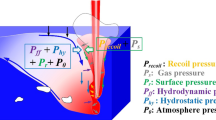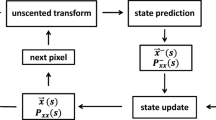Abstract
Pulse coupled neural network (PCNN) has a specific feature that the fire of one neuron can capture its adjacent neurons to fire due to their spatial proximity and intensity similarity. In this paper, it is indicated that this feature itself is a very good mechanism for image filtering when the image is damaged with pep and salt (PAS) type noise. An adaptive filtering method, in which the noisy pixels are first located and then filtered based on the output of the PCNN, is presented. The threshold function of a neuron in the PCNN is designed when it is used for filtering random PAS and extreme PAS noise contaminated image respectively. The filtered image has no distortion for noisy pixels and only less mistiness for non-noisy pixels, compared with the conventional window-based filtering method. Excellent experimental results show great effectiveness and efficiency of the proposed method, especially for heavy-noise contaminated images.
Similar content being viewed by others
References
Yao Qingdong, Bi Houjie, Wang Zhaohua et al., Fundamental of Image Coding (in Chinese), Hangzhou: Zhejian University Press, 1993.
Yang Shubin, Peng Fuyuan, Xie Zhiyuan et al., Laser underwater image filtering for pep and salt noisy images, Infrared and Laser Engineering (in Chinese), 2002, 31(4): 318–321.
Xing Zangju, Qu Yanfeng, Xu Jian et al., Multi-window median filter for pep and salt contaminated images, Electronics and Information Journal (in Chinese), 2002, 24(12): 1912–1916.
Sun, T., Neuvo, Y., Detail-preserving median based filters in image processing, Pattern Recognition Letter, 1994, 15: 341–347.
Florencio, D., Schafer, R., Decision-based median filter using local signal statistics, Proc. SPIE Visual Communications and Image Processing ’94, Vol.2308, 268–275. Aggelos K. Katsaggelos. Chicago, Sept. 1994.
Eng How-Lung, Ma Kai-Kuang, Noise adaptive soft-switching median filter, IEEE Trans. on Image Processing, 2001, 10(2): 242–251.
Eckhorn, R., Reiboeck, H. J., Arndt, M. et al., A neural networks for feature linking via synchronous activity: Results from cat visual cortex and from simulations, in Models of Brain Function (ed. Cotterill, R. M. J.), Cambridge: Cambridge Univ. Prss, 1989.
Eckhorn, P., Neural mechanisms of scene segmentation: recordings from the visual cortex suggest basic circuits or linking field models, IEEE Trans. Neural Networks, 1999, 10(3): 464–479.
Broussard, R. P., Rogers, S. K., Oxley, M. E. et al., Physiologically motivated image fusion for object detection using a pulse coupled neural network, IEEE Trans. Neural Networks, 1999, 10(3): 554–563.
Kinser, J. M., Foveation by a pulse-coupled neural net work, IEEE Trans. Neural Networks, 1999, 10(3): 621–625.
Caufield, H. J., Kinser, J. M., Finding the shortest path in the shortest time using PCNN’s, IEEE Trans. Neural Networks, 1999, 10(3): 604–606.
Wells, D. M., Solving degenerate optimization problems using networks of neural oscillators, Neural Networks, 1992, 5: 949–959.
Johnson, J. L., Pulse-coupled neural nets: Translation, rotation, scale, distortion and intensity signal invariance for images, Appl. Opt., 1994, 33(26): 6239–6253.
Izhikevich, E. M., Class I neural excitability, conventional synapses, weakly connected networks, and mathematical foundations of pulse coupled models, IEEE Trans. Neural Networks, 1999, 10(3): 499–507.
Izhikevich, E. M., Weakly pulse-coupled oscillators. fm interactions, synchronization, and oscillatory associative memory, IEEE Trans. Neural Networks, 1999, 10(3): 508–526.
Xing Zangju, Wang Shoujue, Deng Haojiang et al., A novel filtering algorithm based on extreme median approach, Journal of China Image and Graphics (in Chinese), 2001, 6 (A)(6): 533–536.
Han, W., Lin, W., Minimum-maximum exclusive mean(MMEM) filter to remove impulse noise from highly corrupted images, Electronics Lett., 1997, 33(2): 124–125.
Wang, J., Zhang, D., Progressive switching median filter for the removal of impulse noise from highly corrupted images, IEEE Trans. Circuits and Systems—II: Analog and Digital Signal Processing, 1999, 46(1): 78–80.
Johnson, J. L., Padgett, M. L., PCNN models and applications, IEEE Trans. Neural Networks, 1999, 10(3): 480–498.
Ota, Y., Wilamowski, B. M., Analog implementation of pulse-coupled neural networks, IEEE Trans. on Neural Networks, 1999, 10(3): 539–544.
Rong Guanao, Computer Image Processing (in Chinese), Bejing: Qinghua University Press, 108–146.
Watson, A. B., DCT quantization matrices visually optimized for individual images, in Proc. of SPIE: Human Visual Processing and Digital Display IV, Washington: SPIE, 1993, 1913: 202–216.
Watson, A. B., Efficiency of a model human image code, J. Opt. Soc. Am., 1987, 4(12): 2401–2415.
Zhang Junying, Shi Lin, Shi Meihong, An image filtering method based on pulse-coupled neural networks, Proceedings of the International Conference on Modeling and Simulation in Distributed Applications, Sept 2001, 732–738.
Johnson, J. J., Ritter, D., Observation of periodic waves in a pulse-coupled neural networks, Opt. Lett., 1993, 18(5): 1253–1255.
Hu Zhanhu, Multi-resolution image filtering method based on Bayes estimation, Electronics Journal, 2002, 30(1): 66–68.
Wang Qi, Jiang Lihui, Li Ning et al., Image recovery from the pep and salt contaminated images with morphologic filtering and adaptive fuzzy median filtering, Laser in China (in Chinese), 2001, 28(7): 655–657.
Author information
Authors and Affiliations
Corresponding author
Rights and permissions
About this article
Cite this article
Zhang, J., Lu, Z., Shi, L. et al. Filtering images contaminated with pep and salt type noise with pulse-coupled neural networks. Sci China Ser F 48, 322–334 (2005). https://doi.org/10.1360/03ye0168
Received:
Revised:
Published:
Issue Date:
DOI: https://doi.org/10.1360/03ye0168




